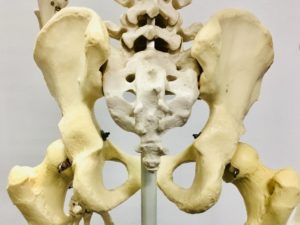 With Christmas holidays just around the corner, coccyx (tail bone) pain when your sitting can be a real pain in the butt…literally.
With Christmas holidays just around the corner, coccyx (tail bone) pain when your sitting can be a real pain in the butt…literally.
Your coccyx is the last segment of bone at the bottom of your spine. This little segment is thought to be the remnant of the tail we once had. The coccyx consists of 3-5 simple vertebral units that are generally fused together. The way that it is joint means that it curves in a forward direction.
Coccyx pain or Coccydynia refers to pain in and around the coccyx though it can radiate to the lower back and buttocks. It can be particularly disabling as generally one of the first complaints sitting down or when moving from sitting to standing. As you can imagine this makes activities such as sitting at work or driving to your Christmas holiday destination very difficult.
The coccyx is also an attachment site for many important muscles of the pelvic floor and it helps to support the anus. It can therefore be painful some people even going to the bathroom.
What could contribute to coccyx pain?
- Giving birth is one of the most common causes of coccyx pain. Due to the position of the coccyx it is susceptible to injury especially in a difficult labour or if instrumentation is needed.
- A hard impact onto the base of your spine, such as a fall, can potentially fracture or dislocate the coccyx. Fortunately, most of the time this will only cause bruising.
- Prolonged pressure or strain on the coccyx. Certain sports such as rowing or cycling particularly for long periods of time can increase the pressure through the coccyx.
- Poor sitting posture. When your sitting the coccyx acts like one leg of a tripod along side your two sitting bones to distribute your weight when you are sitting.
- Weight loss or being overweight. A rapid weight loss can also decrease the cushioning around your tail bone.
- Increased tension in the Levator Ani muscles. These are the deep pelvic floor muscles that attach to your coccyx.
- Being female. Women are five time more likely to develop coccyx pain than men.
What can you do about coccyx pain?
There is no ideal treatment for coccyx pain but there are a few things that you can trial.
- Avoid aggravating activities when able.
- Avoid spending too much time in sitting. If possible, utilise a sit to stand desk at work.
- Standing up and move around regularly.
- Check your sitting position at work.
- Trial a wedge-shaped cushion, donut pillow or gel cushion when your sitting.
If you are experiencing pain over your tailbone, lower back or pelvis, be sure to make an appointment at Bend + Mend in Sydney’s CBD to ensure a quick recovery!





